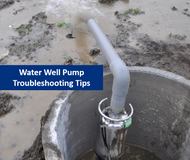Water Well Pump Troubleshooting Tips : Well System Maintenance Guide
Posted by David Cannon on 30th Jun 2021

Owning a well makes you self-sufficient in terms of water economy but it adds to your maintenance responsibilities too. Modern residential wells are integrated with a pumping system. Certainly, being an electromechanical system, the pumping unit is susceptible to operational damage. Well water may comprise contaminants like high levels of iron, natural minerals, soils, and bacterial impurities. Also, the well pumps are exposed to pressure fluctuations, water force, etc. All these factors impact the performance of the pumping system in the residential wells. To maintain the performance and enhance the durability of well pump system, it is essential to identify the damage warnings and troubleshoot the well pump accordingly. This post discusses common damage warnings noticed in well pumps and offers a few water well pump troubleshooting tips.
Damage Warnings in Well Pump Systems
Identifying the warnings in well pumps is essential. Often ignorance of small warnings results in major problems in pump systems such as chocked pipelines, abrupt failure of pumps, etc. To prevent such major problems, here is a few early warning you should pay attention to.
- Air ejection from the pump
- Sand and solid sediments ejection from the pump
- Reduced water pressure
- Too many air bubbles in water
- Unwanted automatic ON/OFF of the pump
If any or a few of the above-mentioned warnings are noticed, the troubleshooting of water well pump may be needed.
Now let us discuss how to troubleshoot the well pump by using a few water well pump troubleshooting tips.
5 Water Well Pump Troubleshooting Tips
Although based on the type of equipment used in the well pumping system, the process of thorough troubleshooting may differ, the following water well pump troubleshooting tips can always be useful.
- Ensure The Power is Turned On: Ensure to turn on the power before even starting to examine the well pump. Check if the electrical circuits are operating properly. The following power-related factors you should check while troubleshooting.
- The power switch near the pressure switch is active.
- There is no power tripping in the double-pole circuit breaker.
Warning: If power tripping in a double-pole circuit breaker is frequent, a thorough checkup of the well pumping system may be required.
- Test the Pressure Switch: The pressure switch can be a problem. If the pressure switch stops sensing pressure properly, the pumping action will not be triggered in well pump systems. To check if the pressure switch is the problem, the following steps can be taken.
- Remove the protective casing from the switch and bang sharply on the tube bellow. If you notice an electric spark, the pressure switch is the problem.
- If you identify the pressure switch as the problem, check its electrical circuitry. If the condition of the switch is too bad, it should be replaced to prevent further damage.
- Check the Pump Controller: If the pressure switch isnât the problem, the pump controller can be. Check for the circuitry of the pump controller. If the controllerâs capacitor is not working or the wired connections are not proper, it can be fixed easily. Check if the capacitor requires replacement. Also, check the circuitry, if any wires are cut or disconnected.
- Check the Air Valve: The air valve is located near the tank. It is exposed to pressure fluctuations the most. This may cause damage to the valve. Sudden buildup or drop in pressure may result in dimensional changes of the valve which eventually results in air leakage through the well pump. That is why during troubleshooting, the air valveâs performance should be tested.
- Check the Tank Quality: If the well tank is damaged, the pump can malfunction. Check for the dents and damage to the well tank.
If all these water well pump troubleshooting tips are followed, the maintenance and repair of damaged pumps become easy. However, the overall performance of the well pump system depends on the quality of equipment. That is why you should source high-quality pumps and pump parts from trusted suppliers like Cannon Water Technology, Inc. The company offers various types of pumps and components from high-end brands like Jesco America Pumps, Seko, etc.

